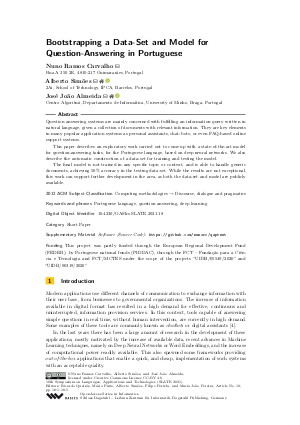Bootstrapping a Data-Set and Model for Question-Answering in Portuguese (Short Paper)
Authors
Nuno Ramos Carvalho,
Alberto Simões  ,
José João Almeida
,
José João Almeida 
-
Part of:
Volume:
10th Symposium on Languages, Applications and Technologies (SLATE 2021)
Part of: Series: Open Access Series in Informatics (OASIcs)
Part of: Conference: Symposium on Languages, Applications and Technologies (SLATE) - License:
 Creative Commons Attribution 4.0 International license
Creative Commons Attribution 4.0 International license
- Publication Date: 2021-08-10
File

PDF
OASIcs.SLATE.2021.18.pdf
- Filesize: 469 kB
- 5 pages
Document Identifiers
Subject Classification
ACM Subject Classification
- Computing methodologies → Discourse, dialogue and pragmatics
Keywords
- Portuguese language
- question answering
- deep learning
Metrics
- Access Statistics
-
Total Accesses (updated on a weekly basis)
0Document
0Metadata
Abstract
Question answering systems are mainly concerned with fulfilling an information query written in natural language, given a collection of documents with relevant information. They are key elements in many popular application systems as personal assistants, chat-bots, or even FAQ-based online support systems. This paper describes an exploratory work carried out to come up with a state-of-the-art model for question-answering tasks, for the Portuguese language, based on deep neural networks. We also describe the automatic construction of a data-set for training and testing the model. The final model is not trained in any specific topic or context, and is able to handle generic documents, achieving 50% accuracy in the testing data-set. While the results are not exceptional, this work can support further development in the area, as both the data-set and model are publicly available.
Cite As Get BibTex
Nuno Ramos Carvalho, Alberto Simões, and José João Almeida. Bootstrapping a Data-Set and Model for Question-Answering in Portuguese (Short Paper). In 10th Symposium on Languages, Applications and Technologies (SLATE 2021). Open Access Series in Informatics (OASIcs), Volume 94, pp. 18:1-18:5, Schloss Dagstuhl – Leibniz-Zentrum für Informatik (2021)
https://doi.org/10.4230/OASIcs.SLATE.2021.18
BibTex
@InProceedings{carvalho_et_al:OASIcs.SLATE.2021.18,
author = {Carvalho, Nuno Ramos and Sim\~{o}es, Alberto and Almeida, Jos\'{e} Jo\~{a}o},
title = {{Bootstrapping a Data-Set and Model for Question-Answering in Portuguese}},
booktitle = {10th Symposium on Languages, Applications and Technologies (SLATE 2021)},
pages = {18:1--18:5},
series = {Open Access Series in Informatics (OASIcs)},
ISBN = {978-3-95977-202-0},
ISSN = {2190-6807},
year = {2021},
volume = {94},
editor = {Queir\'{o}s, Ricardo and Pinto, M\'{a}rio and Sim\~{o}es, Alberto and Portela, Filipe and Pereira, Maria Jo\~{a}o},
publisher = {Schloss Dagstuhl -- Leibniz-Zentrum f{\"u}r Informatik},
address = {Dagstuhl, Germany},
URL = {https://drops.dagstuhl.de/entities/document/10.4230/OASIcs.SLATE.2021.18},
URN = {urn:nbn:de:0030-drops-144355},
doi = {10.4230/OASIcs.SLATE.2021.18},
annote = {Keywords: Portuguese language, question answering, deep learning}
}
Author Details
Funding
This project was partly funded through the European Regional Development Fund (FEDER), by Portuguese national funds (PIDDAC), through the FCT - Fundação para a Ciência e Tecnologia and FCT/MCTES under the scope of the projects "UIDB/05549/2020" and "UIDB/00319/2020"
Supplementary Materials
- Software (Source Code) https://github.com/nunorc/qaptnet
References
- N.R. Carvalho, 2019 (last accessed: 28- 08-2019). URL: https://github.com/nunorc/qaptnet.
- Zihang Dai, Zhilin Yang, Yiming Yang, Jaime Carbonell, Quoc V Le, and Ruslan Salakhutdinov. Transformer-xl: Attentive language models beyond a fixed-length context. arXiv preprint, 2019. URL: http://arxiv.org/abs/1901.02860.
- Jacob Devlin, Ming-Wei Chang, Kenton Lee, and Kristina Toutanova. Bert: Pre-training of deep bidirectional transformers for language understanding. arXiv preprint, 2018. URL: http://arxiv.org/abs/1810.04805.
-
SurveyMonkey Audience Drift and Myclever Salesforce. The 2018 state of chatbots report. how chatbots are reshaping online experiences, 2019.

-
Ian Goodfellow, Yoshua Bengio, and Aaron Courville. Deep learning. MIT press, 2016.

- Diederik P Kingma and Jimmy Ba. Adam: A method for stochastic optimization. arXiv preprint, 2014. URL: http://arxiv.org/abs/1412.6980.
-
Emilio Soria Olivas. Handbook of Research on Machine Learning Applications and Trends: Algorithms, Methods, and Techniques: Algorithms, Methods, and Techniques. IGI Global, 2009.

- Pranav Rajpurkar, Jian Zhang, Konstantin Lopyrev, and Percy Liang. Squad: 100,000+ questions for machine comprehension of text. arXiv preprint, 2016. URL: http://arxiv.org/abs/1606.05250.
-
Zhilin Yang, Zihang Dai, Yiming Yang, Jaime Carbonell, Russ R Salakhutdinov, and Quoc V Le. Xlnet: Generalized autoregressive pretraining for language understanding. In Advances in neural information processing systems, pages 5754-5764, 2019.

